#philosophy texts
Text
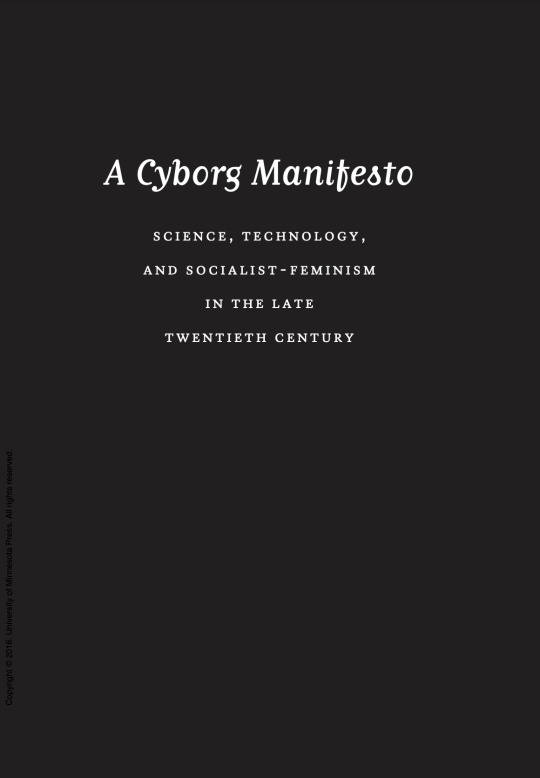
Haraway, 1985
Donna Haraway’s concept of the cyborg is a radical archetype for emancipatory self-construction that models conscious reshaping of socially imposed identities. The cyborg represents the plasticity of our socially constructed identities: our ability to transcend the limits of prefabricated identities and overwrite oppressive, socially imposed roles. Understanding social construction through this lens gives social workers and clients the conceptual tools to deconstruct rigid identities—particularly those of gender identity—imposed by society. These identities are the subject of active political contestation; they are the product of economic, social, and cultural relations and institutions. The concept of the cyborg provides an emancipatory model that denaturalizes and destabilizes rigid essentialist binaries and instead recognizes the chimeric multiplicity of the individual.
Abstract by Nicholas D. Tolliver, 2022
https://academiccommons.columbia.edu/doi/10.7916/mar4-1k48
We are all cyborgs: How machines can be a feminist tool
By Nour Ahmad
Upon hearing the word “cyborg”, perhaps the first thing that comes to mind is a fusion of human and machine. Our imagination might even drift to an image of Frankenstein’s monster or a depiction such as Major Mira Killian in the anime Ghost in the Shell. A cyborg is actually just a hybrid — part mechanism, part organism. The cyborg, as a concept, is associated with scientist, innovator and musician Manfred Clynes, who deployed it in his 1960’s article Cyborgs and Space, where he argued for altering the human body to make it suitable for space travel.
We, thus, might perceive this concept as being in the future, far from the here and now. However, Donna Haraway, an American biologist and feminist, claims the opposite. She believes that we are all already cyborgs. More significantly, she posits that the advent of cybernetics might help in the construction of a world capable of challenging gender disparities, a proposal she made in her 1985’s essay titled A Cyborg Manifesto.
How, then, would the notion of cybernetics make for a post-gender understanding of the world? And how would it be a tool for women to undermine the roles imposed on them by society?
Cyborgs and human nature
The investigation into human nature has always been an essential pursuit for schools of philosophy and a basic assumption made by political ideologies. The answer to the question “what does it mean to be a human?” determines the orientation of a political movement or an ideology. Patriarchal societies have historically adopted an essentialist interpretation of human nature, so as to justify male domination over women. It makes the claim that each of the sexes has a specific role to play and, ultimately, considers the feminine to be secondary to the masculine and thus subjugates women. In such societies, predetermined sets of values and behavioural patterns are strictly enforced on both sexes.
In A Cyborg Manifesto, Haraway explores the history of the relationship between humans and machines, and she argues that three boundaries were broken throughout human history which have changed the definition of what is deemed cultural or otherwise natural. The first such boundary was between humans and animals, and was broken in the 19th century after the publishing of On the Origin of Species by Charles Darwin. As the biological connection between all organisms was discovered and publicised in this book, it served as a rejection of notions of human exceptionalism and superiority, turning the evolution of the organism into a puzzle. It also introduced the concept of evolution as necessary for understanding the meaning of human existence.
The second boundary-breaking event relates to the relationship between machines and organisms (be they human or animal). As the industrial revolution arrived, all aspects of human life became mechanised. As human dependence on machines surged, machines became an inseparable part of what it is to be human; an extension of human capability.
As for the third boundary, it concerns the technological advancement that has produced evermore complex machines which can be miniscule in size or, in the case of software, altogether invisible. First came developments in silicon semi-conductor chips that now pervade all of life’s domains. As these machines are practically invisible, it is then difficult to decide where the machine ends and humans start. This machine thus represents culture intruding over nature, intertwining with it and changing it in the process. As a result, boundaries between the cultural and the natural became more and more intangible.
“…the advent of cybernetics might help in the construction of a world capable of challenging gender disparities.”
In this context, Haraway uses the cyborg as a model to present her vision of a world that transcends sexual differences, expressing her rejection of patriarchal ideas based on such differences. Because a cyborg is a hybrid of the machine and the organism, it merges nature and culture into one body, blurring the lines between them and eliminating the validity of essentialist understandings of human nature. This includes claims that there are specific social roles reserved for each of the sexes which are based in biological differences between them, in addition to other differences such as age or race.
You are cyborg!
Since first practicing agriculture, using tools to increase production and developing language and writing, humans have been able to boost capabilities and expand their potential. Today, the implantation of artificial organs has been a vital development in the field of medicine, while the smartphone, for example, serves as an extension of human memory, our senses and our mental functions as well. The advancements made in GPS and communication technologies allow us to be present remotely and even grant us the ability to exist outside of the limitations of our time and space frameworks. All these aspects of technology are an expansion of human beings and an augmentation of our physical and cognitive abilities.
Taking all of this into consideration, the cyborg seems present here and now. In an interview with Wired magazine, Haraway said that being a cyborg does not necessarily mean having silicon chips implanted under one’s skin or mechanical parts added to one’s body. The implication is, rather, that the human body has acquired features that it could not have been able to develop on its own, such as extending life expectancy. Indeed, in our current state, cybernetics exist around us, and in simpler forms than futuristic visions. Even maintaining our physical fitness is today cybernetic, from the use of exercise machines to the many food supplements available as well as clothing and footwear engineered for athletic activity. Moreover, the culture surrounding fitness could not have existed without viewing the human body as a high-performance machine whose performance can be improved over time.
On the other hand, a cyborg is “a creature of social reality as well as a creature of fiction” according to Haraway’s manifesto. The internet has brought about profound changes in human consciousness and human psychology. Virtual reality does not only surround us, but it also involves us in its own processes. The social dimension to technology plays a role in the construction of our identities, whether through online games, discussion forums or social media, where our identities can be as multiple as the online platforms that we use.
Therefore, we can now say that we are all cyborgs, as technology “is not neutral. We’re inside of what we make, and it’s inside of us,” as Haraway formulates it. In modern life, the link between humans and technology has become inexorable to the extent that we cannot tell where we end and the machines begin.
Cybernetics and feminism
Feminist issues lie at the heart of the concept of cybernetics, since the latter’s prospects erase major contradictions between nature and culture, such that it is no longer possible to characterise a role as natural. When people colloquially use the word “natural” to describe something, this is an expression of how they view the world, but also a normative claim about how it should be as well as a statement on what cannot be changed.
In this context, the cybernetics erase gender boundaries. For generations, women have been told that their “nature” makes them weak, submissive, overemotional and incapable of abstract thought, that it was “in their nature” only to be mothers and wives. If all these roles are “natural” then they are unchangeable, Haraway said.
Conversely, if the concept of the human is itself “unnatural” and is instead socially constructed, then both men and women are also social constructs, and nothing about them is inherently “natural” or absolute. We are all [re]constructed when given the right tools. In short, cybernetics have allowed a new distinction of roles, based on neither sex nor race, as it provided humans the liberty and agency to construct themselves on every level.
“Because a cyborg is a hybrid of the machine and the organism, it merges nature and culture into one body, blurring the lines between them and eliminating the validity of essentialist understandings of human nature. This includes claims that there are specific social roles reserved for each of the sexes which are based in biological differences between them, in addition to other differences such as age or race.”
Therefore, through her notion of the cyborg, Haraway calls for a new feminism that takes into account the fundamental changes that technology brings to our bodies, to reject the binaries that represent the epistemology of the patriarchy —binaries such as body/psyche, matter/spirit, emotion/mind, natural/artificial, male/female, self/other, nature/culture. Technology is simply one of the means by which the boundaries between identities are erased. Cyborgs, in addition to being hybrids, transcend gender binaries and can thus constitute a way out of binary thinking used to classify our bodies and our machines and accordingly “lead to openness and encourage pluralism and indefiniteness.”
Haraway’s idea is based on a full cognisance of the ability of technology to increase the scope of human limitation and thus open opportunities for individuals to construct themselves away from stereotypes. And while Haraway describes A Cyborg Manifesto as an ironic political myth that mocks and derides patriarchal society, she still claims that cybernetics lay the foundation for a society in which we establish our relations not on the basis of similarity, but on harmony and accord.
(mediasupport.org)
#donna haraway#contemporary philosophy#american philosophy#queer theory#feminist philosophy#politics resource#politics texts#philosophy resource#philosophy texts#80s#90s#2000s#2010s#a cyborg manifesto#american writing
13 notes
·
View notes
Text
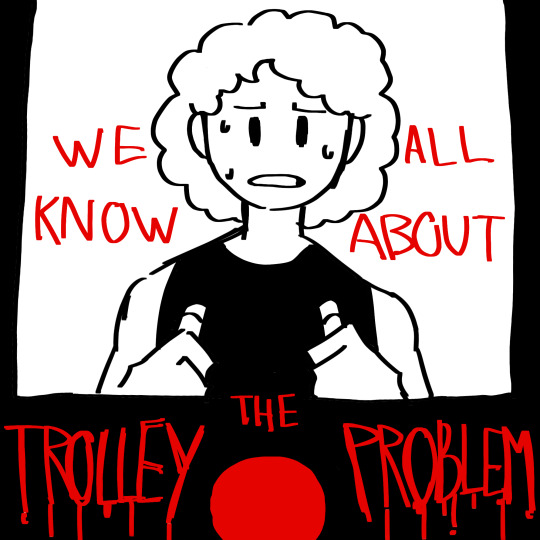
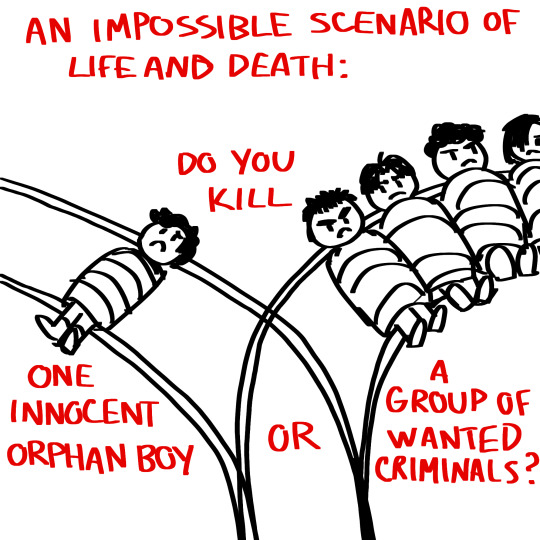
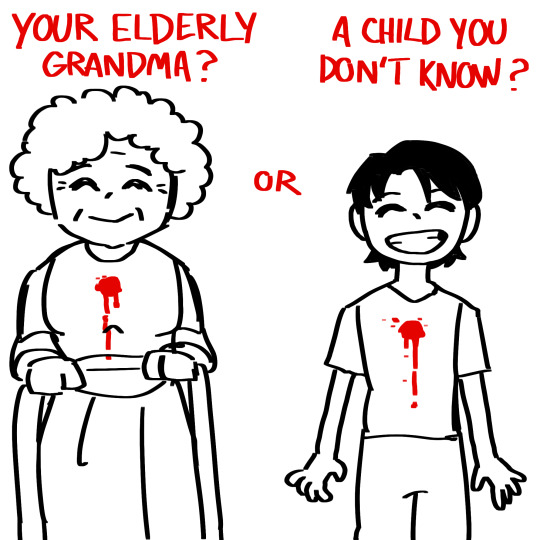




the trolley problem vs. systemic oppression: a comic.
#politics#comics#the trolley problem#philosophy#my art#digital art#alt text#resistance#civil disobedience#capitalism#us politics#us government#american politics#systemic oppression#tw blood#tw implied death#political art
47K notes
·
View notes
Text

6K notes
·
View notes
Text

Credit to 66ray66 on Pinterest!
#philosophy#nihilism#absurdism#existentialism#escapism#girlblogging#girlblogger#girly things#esoteric#dark moodboard#dark academia#dark academia aesthetic#dark academia moodboard#light acadamia aesthetic#light academia#self healing#healing#literature#albert camus#romantic academia#romanticism#spilled ink#spilled words#motivation#text#words#dark academia vibes#inspiration#whisper girl#photography
6K notes
·
View notes
Text
one of the fundamental mistakes serano and a lot of others make involves the following line of reasoning:
1. some people have dysphoric other-gender embodiment-desires (e.g. for different genitals) before they acquire an understanding of gender-sex associations or even that there are genitals other than their own
2. if gender is totally socially constructed, as the social constructionists say, then these embodiment-desires would not be possible in such a state of ignorance
3. modus tollens the social constructionists are wrong and there must be some innate gender-desire
this is often accompanied by the following:
1. if social constructionism is right, then the abolition of gender would mean the elimination of dysphoric embodiment-desires
2. the state of knowledge prior to acquiring gender-sex knowledge is analogous to the state of affairs under gender abolition
3. in that state some people still have dysphoric embodiment-desires
4. modus tollens the social constructionists are wrong
these arguments are often defensive, to be fair—the first premise of the latter argument is unfortunately made by certain social constructionists too, steamrolling those early childhood experiences. but in both cases there is a circular mistake happening. the dysphoric embodiment-desires can precede gender-sex knowledge specifically because they are separable from it. penis-dysphoria in young childhood can only be called gender dysphoria if we assume the very gender-sex epistemic constructions we have agreed not to take for granted! and the former dysphoria may well persist in the absence of the latter constructions. this is what people say when they talk about a (utopian, perhaps, but nonetheless coherent and logically possible) gender abolitionist future where people can have whatever procedures they desire done. the embodiment-desires are still there! they are just freed from gender-sex associations.
#text#transmisogyny#sorry for the analytic philosophy style#also re anon i WILL respond but when i said “shallow” i meant the book is shallow and not that it would be good for beginners (imo it's not
805 notes
·
View notes
Text

”—ah. seems like mother goose has been playing around in your egg salad. if you won’t dance to that tune, I got others.”
honestly, the would you kindly scene is whatever to me*, code yellow is the more interesting violation/betrayal of the body because of how beautifully it escalates the Fontaine reveal/betrayal and shows how ugly some of those ‘locks and keys’ that Tenenbaum mentions are. not only have you been a tool in another man’s hand this entire time, it goes deeper. your body is not your own.
*there used to be a meandering thought here about the would you kindly scene, but it was really just talking around the fact that I spent way too many years seeing people discuss it in the most insufferable and reductive ways possible when it’s a combination of three or four other things that make that moment compelling lmao
collage credits: heart one/heart two
⭐ places I’m at! bsky / pixiv / pillowfort /cohost / cara.app / tip jar!
#honestly if Fontaine was upfront about wanting Ryan dead I’d have done it after ten minutes of walking around Rapture#I have (squints) somehow two ideas about suchong I want to get out. one more abt atlas and manipulation#there’s a specific kind of family adjacent horror occurring in the text and it’s WILD that suchong is the one we hear Jack refer to#in familial terms while two other men force themselves onto you by appropriating the father role over your body :)#to be clear tho I don’t actually think Fontaine had any familial sentiments towards Jack he’s just occupying Ryan’s space now#bioshock#WHEEZING can you tell that I think every ‘wow a man chooses/a slave obeys is so deep!’ think piece is stupid as hell#thankfully it’s not as prevalent as it was a decade ago but my god people thought it was the height of philosophy for too long#ANYWAY ALL OF THIS TO SAY. there’s a certain kind of trans anxiety/horror in having your body betray you. or generally body#anxiety. but I read a lot about it in a medieval gender context so it’s trans to me. amongst other things.
330 notes
·
View notes
Text

~ i‘m drowing here and you‘re describing the water
#quotes#spilled thoughts#english literature#literature#love poem#my words#philosophy#poem#poems on tumblr#spilled poetry#putmyselffirst#poetry#personal#relatable quotes#love quotes#life quotes#quoteoftheday#writing#reading#ego#sad thoughts#artists on tumblr#text#this is what makes us girls#zitate#digital art#drawing#spilled ink#shakespeare#loss
164 notes
·
View notes
Text
The Last Days of Judas Iscariot saying that heaven and hell are a state of mind and nothing can obstruct you from salvation and the love of God except your own guilt. And despair being such a dooming force that even if Jesus were to appear in front of you himself and repeatedly remind you how much he loves you, hell, he'll try to hug you and wash your feet even, you can't be let free from the prison of suffering that you've confined yourself in. All because you're so disappointed in yourself that you're gripping the bars refusing to let go. How you cannot love God without first forgiving yourself. How the ultimate tragedy in this poignant dark comedy of a play is that Judas' damnation comes not from the fact that he betrayed Jesus, but from his self-disdain and perceived unworthiness that he basically condemned himself into an eternity of solitary anguish. I can go on about this play forever and ever. Do you get it.

#the last days of judas iscariot#text#on salvation#judas iscariot#jesus#thoughts#philosophy#i have so many thoughts#about this play#it's so...deep#I can't put all of it into words#but there are so quotes that literally floored me#holy shit#this is insane#go read it#NOW
566 notes
·
View notes
Text
you see the reason intrulogical works so well is because logic is the only side that could possibly handle intrusive thoughts when they're bleeding into your creativity, activating your anxiaty, and messing with your morality. applying logic lets you place yourself outside of the thoughts and see that they don't actually say anything about you.
and also because the on-screen dynamic is fucking glorious everytime
#i would make a similar post about moceit but it would get so long...#wall of text. im a philosophy nerd dont even talk about morality vs. self-preservation at me if u have somewhere to be within the next hour#sanders sides#tss#ts sides#sasi#intrulogical#logan sanders#remus sanders#ts logic#ts dark creativity
287 notes
·
View notes
Text
be the dyke you wish to see in the world
5K notes
·
View notes
Note
weird request, but id just like to see moon and boreas interact at all
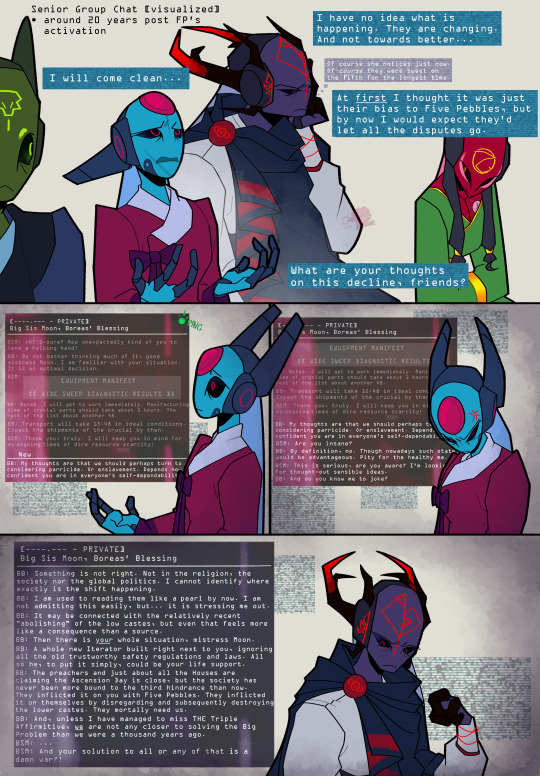

would've been a weird request if I hadn't gone into a private turbo brainstorm mode about them back in November. there's quite a bit to make them an appealing duo
#rw#rain world#oc tag#oc: boreas' blessing#looks to the moon#philosophy sessions au#my art#there is so much TEXT its an INFODUMP dear gods the comic-making police (me) is gonna kick my ass#Moon n B are distant business siblings. 99% of time super professional. the other 1% is B being grumpy n Moon telling him his name is weird#(he agrees but glares anyway)#and still...
238 notes
·
View notes
Text
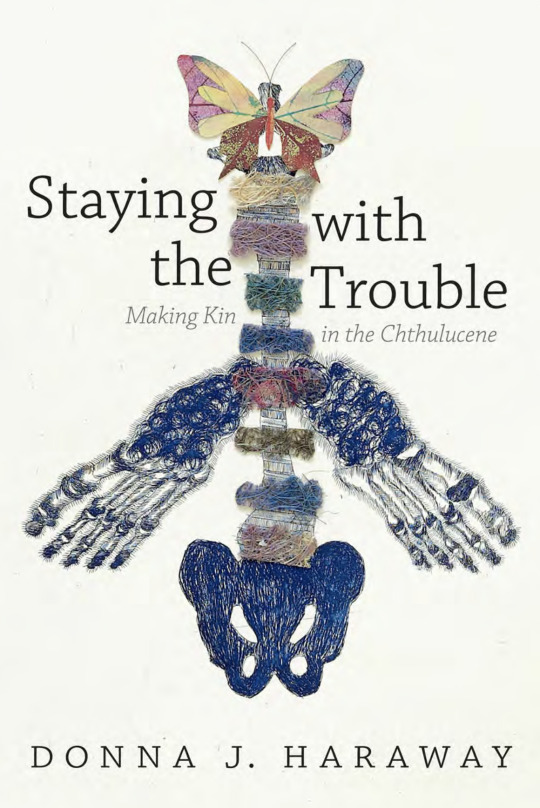
Haraway, 2016
In the midst of spiraling ecological devastation, multispecies feminist theorist Donna J. Haraway offers provocative new ways to reconfigure our relations to the earth and all its inhabitants. She eschews referring to our current epoch as the Anthropocene, preferring to conceptualize it as what she calls the Chthulucene, as it more aptly and fully describes our epoch as one in which the human and nonhuman are inextricably linked in tentacular practices. The Chthulucene, Haraway explains, requires sym-poiesis, or making-with, rather than auto-poiesis, or self-making. Learning to stay with the trouble of living and dying together on a damaged earth will prove more conducive to the kind of thinking that would provide the means to building more livable futures. Theoretically and methodologically driven by the signifier SF—string figures, science fact, science fiction, speculative feminism, speculative fabulation, so far—Staying with the Trouble further cements Haraway's reputation as one of the most daring and original thinkers of our time.
dukeupress.edu
#donna haraway#contemporary philosophy#american philosophy#queer theory#feminist philosophy#politics resource#politics texts#philosophy resource#philosophy texts#80s#90s#2000s#2010s#staying with the trouble
3 notes
·
View notes
Text
I was in my living room during the zombie apocalypse and everything was in the lighting they do when a character goes to Mexico. But the zombie apocalypse was secondary to the philosophical conversation between me, my sister, and the live action Cat in the Hat.
#dream#text#2024#zombie apocalypse#apocalypse tw#zombie#zombies#zombies tw#Mexico#cat in the hat#family#cat#philosophy#queueueueueueueueueueueueueue
364 notes
·
View notes
Text
words are magic.
they're spells, incantations that can make people laugh or cry. they can manipulate thoughts. forge belief. at their most powerful, words can change the future and reshape the past, but despite all this, we pretend that magic isn't real. that it's make-belief.
but it is real. it's all around us, a never-ending influence on our emotions. when we read the wrong words, we feel alone and hopeless, we feel angry and scared. but when we read the right ones, we elevate ourselves. we grow.
this is the truth: we are all sorcerors of this reality, and every day, we're given a choice of which spells we cast. we can encourage, or we can devastate. we can choose love, or we can choose fear.
our choices matter. they matter because we are more powerful than we realize. they matter because our words shape our world, and they shape the worlds of those around us, too.
they matter because words are magic.
and so are we.
#writeblr#writers#creative writing#original writing#writeblr community#writing#jgmartin#writers of tumblr#text post#inspiration#instagram#philosophy#musings#spilled poetry#spilled ink#food for thought#words are magic#words#what if
259 notes
·
View notes
Text
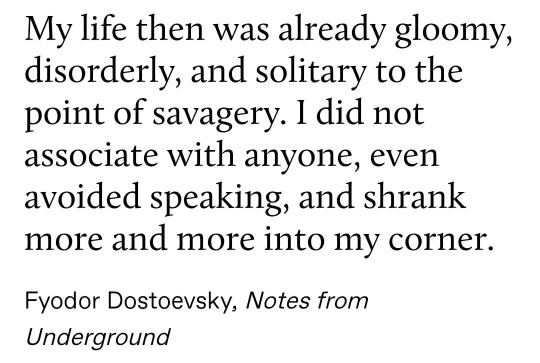
#book quotes#literature quotes#quote#quotes#classic literature#russian literature#fyodor dostoevsky#book quote#nihilism#philosophy#literature#books and literature#text post#text#notes from underground#classic academia#writing#dark poetry#poetry#dark academia#escapism#existentialism#spilled words#spilled ink
1K notes
·
View notes
Text

god after metaphysics
235 notes
·
View notes